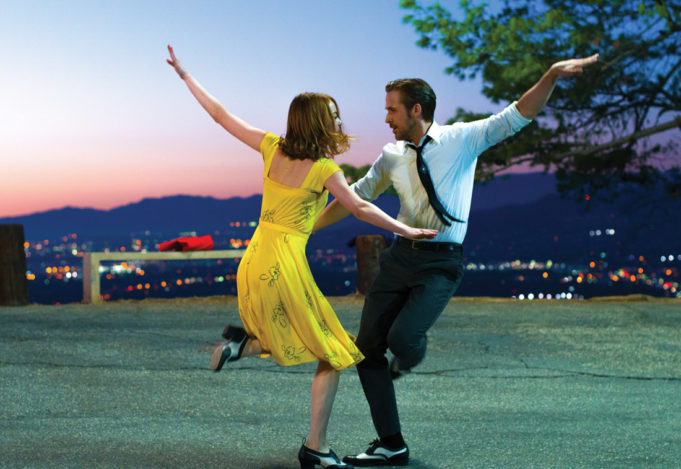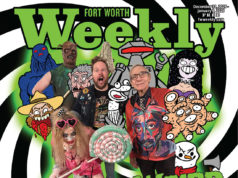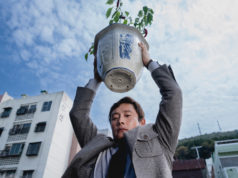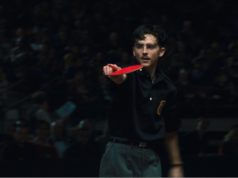A movie that can blow the doors off the theater, La La Land is set in the present day, but in every other respect, it’s a throwback to Singin’ in the Rain, The Band Wagon, An American in Paris, and others from the opulent golden age of Hollywood musicals. We’re talking the same vibrant colors, lush orchestral jazz music, unabashed optimism and romanticism, and characters bursting into song and dance on the street. Most films are content to merely quote from those movies (like this year’s Hail, Caesar!) rather than try to be them. That’s understandable: Sustaining the wit, invention, and exuberance of those old musicals at feature length is incredibly difficult — remember Woody Allen’s Everyone Says I Love You? Yet that’s exactly what writer-director Damien Chazelle manages, and the result is enough to make you leap out of your seat and punch the air in triumph.
Our lovers here are Mia (Emma Stone), an aspiring Hollywood actress, and Sebastian (Ryan Gosling), a jazz pianist who dreams of owning his own club. They fall for each other after meeting at an L.A. party, and he inspires her to write the roles for herself that the industry isn’t offering. However, their relationship threatens to unravel after he takes a job playing backup for Keith (John Legend), a music-school friend who’s now a wildly successful jazz fusion act. The gig pays well, but Sebastian’s touring the country for weeks on end, and for a guy who wants to be Thelonious Monk, playing squiggly synth lines in front of laser lights is a special kind of hell.
This is Chazelle’s third movie, and it feels like the one he always had in him but didn’t have the budget or stars to pull off until now. The movie starts like a house afire with the Latin-tinged opening number “Another Day of Sun,” filmed in a single unbroken take with a freeway overpass full of commuters dancing on top of their cars. It’s an awe-inspiring logistical feat not only by Chazelle but also choreographer Mandy Moore (who works on TV’s Dancing With the Stars) to execute a large-scale number with such intricate camerawork. The filmmakers do something similar with the first half of the second number, “Someone in the Crowd,” with Mia and her roommates (Callie Hernandez, Sonoya Mizuno, and Jessica Rothe) popping in and out of the frame as they dance through their apartment while the camera glides along on its own path.
The cleverness extends to the score by Chazelle’s fellow-traveling composer Justin Hurwitz (with lyrics by Benj Pasek and Justin Paul), as the number “A Lovely Night” is interrupted by Mia’s iPhone, the default ringtone matching the rhythm of the song. The movie is suffused with affection for the city of Los Angeles and makes good use of its locations. One dance number takes place at the Griffith Observatory planetarium, where Sebastian and Mia defy gravity — with the help of some wirework — and dance among the stars. It’s the most delirious movie-musical moment of this century.
All this flamboyance and energy is attached to a smart script that satirizes the hustling L.A. scene and gives a glimpse of how dehumanizing the audition process can be in Tinseltown — one audition requires Mia to deliver the line, “No, Jamal, you be trippin’,” while another one makes her run a gamut in the form of a hallway lined with other red-haired actresses who all seem to be taller than her. Chazelle knows when to get out of his stars’ way, and he does so during a tense domestic squabble over a dinner table. Like An American in Paris, this movie concludes with an extended dream ballet that imagines a different future for the couple, and the note of romantic resignation that it leads up to is beautifully realized.
I just wish Chazelle had figured out a way to reconcile its love of the past with today. Keith calls out Sebastian for being stuck in the musical past, but Chazelle seems stuck there with him. His musical taste is only slightly less conservative than Woody Allen’s. For a movie that pays tribute to making new things, it seems weirdly disconnected from the culture now. (Keith’s jazz-fusion national act isn’t even credible, though when John Legend is singing, you could be persuaded that it is.)
Fortunately, the director knows what he has in his stars. This is the third movie Gosling and Stone have done together, and while their dancing won’t erase memories of Gene Kelly and Cyd Charisse, they generate a magnetism all their own when they’re simply sitting together at the piano singing the melancholy, rhetorical ballad “City of Stars” and delighting in each other’s company.
Gosling’s trademark cool is essential to this movie, but it’s Stone who gives the film its wounding power, specifically during a late scene when Mia lands an audition for a major film seemingly out of nowhere. The song she sings, “Audition (The Fools Who Dream),” is destined to be beaten to death by every woman trying out for a Broadway show in the near future, and what really makes it is the petrified glint in Stone’s eyes as she sings full-throatedly over a swelling orchestra. That look captured by Chazelle’s camera makes you understand what kind of courage it takes for Mia to open herself up like this in front of an audience. This actress has always known how to make us laugh, but in her first great role in a great movie, she shows she can make us cry, too, and she raises La La Land from a fun musical into a deeply moving testament to the power of the creative spirit. As she sings, “Bring on the rebels / The ripples from pebbles / The painters and poets and plays.”












